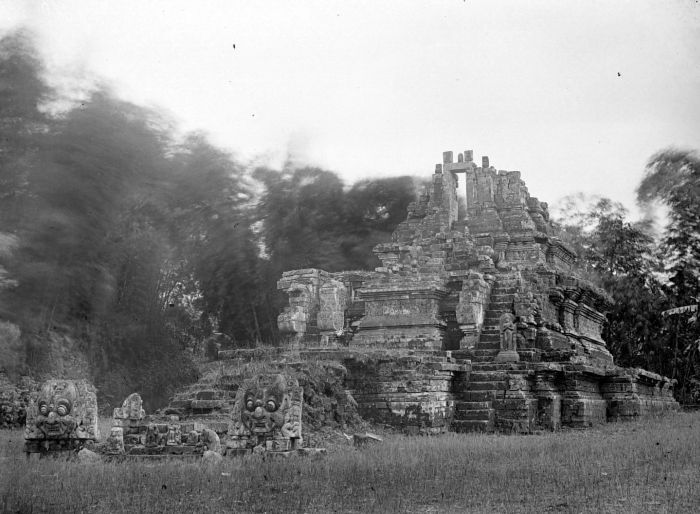Jago Temple on:
[Wikipedia]
[Google]
[Amazon]
 Jago temple ( Indonesian: ''Candi Jago'') is a 13th-century
Jago temple ( Indonesian: ''Candi Jago'') is a 13th-century
 Jago temple ( Indonesian: ''Candi Jago'') is a 13th-century
Jago temple ( Indonesian: ''Candi Jago'') is a 13th-century Hindu
Hindus (; ; also known as Sanātanīs) are people who religiously adhere to Hinduism, also known by its endonym Sanātana Dharma. Jeffery D. Long (2007), A Vision for Hinduism, IB Tauris, , pp. 35–37 Historically, the term has also be ...
temple
A temple (from the Latin ) is a place of worship, a building used for spiritual rituals and activities such as prayer and sacrifice. By convention, the specially built places of worship of some religions are commonly called "temples" in Engli ...
from the Singhasari
Singhasari ( or , ), also known as Tumapel, was a Javanese people, Javanese Hindu-Buddist empires, Hindu-Buddhist Monarchy, kingdom located in east Java (island), Java between 1222 and 1292. The kingdom succeeded the Kingdom of Kediri as th ...
kingdom in East Java
East Java (, , ) is a Provinces of Indonesia, province of Indonesia located in the easternmost third of Java island. It has a land border only with the province of Central Java to the west; the Java Sea and the Indian Ocean border its northern ...
, Indonesia
Indonesia, officially the Republic of Indonesia, is a country in Southeast Asia and Oceania, between the Indian Ocean, Indian and Pacific Ocean, Pacific oceans. Comprising over List of islands of Indonesia, 17,000 islands, including Sumatra, ...
, located about from Malang
Malang (; , ), historically known as Tumapel, is an inland List of regencies and cities of Indonesia, city in the Indonesian Provinces of Indonesia, province of East Java. It has a history dating back to the age of the Singhasari, Singhasari K ...
. The Nagarakretagama
The ''Nagarakretagama'' or ''Nagarakṛtāgama'', also known in Bali as ''Desawarnana'' or ''Deśavarṇana'', is an Old Javanese eulogy to Hayam Wuruk, a Javanese king of the Majapahit Empire. It was written on lontar as a ''kakawin'' by ...
, written in 14th century, describes this temple as ''Jajaghu'' (English: "majestic"), and mentions it as one of the temples visited by King Hayam Wuruk
Hayam Vuruk ( Indonesian: ''Hayam Wuruk'', Sanskrit: हयम् वुरुक्, Kawi: ꦲꦪꦩ꧀ꦮꦸꦫꦸꦏ꧀) (1334–1389), also called Rajasanagara, Pa-ta-na-pa-na-wu, or Bhatara Prabhu after 1350, was a Javanese Hindu emperor fr ...
during his royal tour across East Java.
After his death in 1268, the Singhasari
Singhasari ( or , ), also known as Tumapel, was a Javanese people, Javanese Hindu-Buddist empires, Hindu-Buddhist Monarchy, kingdom located in east Java (island), Java between 1222 and 1292. The kingdom succeeded the Kingdom of Kediri as th ...
King Vishnuvardhana was deified here as Shiva
Shiva (; , ), also known as Mahadeva (; , , Help:IPA/Sanskrit, ɐɦaːd̪eːʋɐh and Hara, is one of the Hindu deities, principal deities of Hinduism. He is the God in Hinduism, Supreme Being in Shaivism, one of the major traditions w ...
, in the form of Bodhisattva
In Buddhism, a bodhisattva is a person who has attained, or is striving towards, '' bodhi'' ('awakening', 'enlightenment') or Buddhahood. Often, the term specifically refers to a person who forgoes or delays personal nirvana or ''bodhi'' in ...
Avalokitesvara. The temple's bas-relief
Relief is a sculptural method in which the sculpted pieces remain attached to a solid background of the same material. The term ''relief'' is from the Latin verb , to raise (). To create a sculpture in relief is to give the impression that th ...
s depict scenes from the ''Kunjarakarna'', ''Parthayajna'', ''Arjunavivaha'', and ''Krishnayana''.
The name of Adityawarman
Adityawarman (formal regnal name Maharajadiraja Srīmat Srī Udayādityawarma Pratāpaparākrama Rājendra Maulimāli Warmadewa. ) was a king of Malayapura Suvarnabhumi, and is the successor of the Mauli dynasty based in central Sumatra. He ...
appears in 1343 on an image of the Bodhisattva
In Buddhism, a bodhisattva is a person who has attained, or is striving towards, '' bodhi'' ('awakening', 'enlightenment') or Buddhahood. Often, the term specifically refers to a person who forgoes or delays personal nirvana or ''bodhi'' in ...
Manjusri
Manjushri () is a ''bodhisattva'' who represents ''Prajñā (Buddhism), prajñā'' (transcendent wisdom) of the Buddhas in Mahāyāna Buddhism. The name "Mañjuśrī" is a combination of Sanskrit word "wikt:%E0%A4%AE%E0%A4%9E%E0%A5%8D%E0%A4%9C%E0 ...
.
See also
*Candi of Indonesia
A candi (, ) is a Hindu temple, Hindu or Buddhist temple in Indonesia, mostly built during the ''Zaman Hindu-Buddha'' or "Indianized kingdom, Hindu-Buddhist period" between circa the 4th and 15th centuries.
The ''Kamus Besar Bahasa Indonesia'' ...
* Hinduism in Java
Hinduism has historically been a major religious and cultural influence in Java, Indonesia. Hinduism was the dominant religion in the region before the arrival of Islam. In recent years, it has also been enjoying something of a resurgence, parti ...
* Indonesian Esoteric Buddhism
Indonesian Esoteric Buddhism was the tradition of Esoteric Buddhism found in Maritime Southeast Asia which emerged in the 7th century along the maritime trade routes and port cities of the Indonesia, Indonesian islands of Java and Sumatra as well ...
* Jawi Temple
* Singhasari temple
References
Archaeological sites in Indonesia Buildings and structures in East Java Singhasari 13th-century Hindu temples Cultural Properties of Indonesia in East Java {{Asia-archaeology-stub